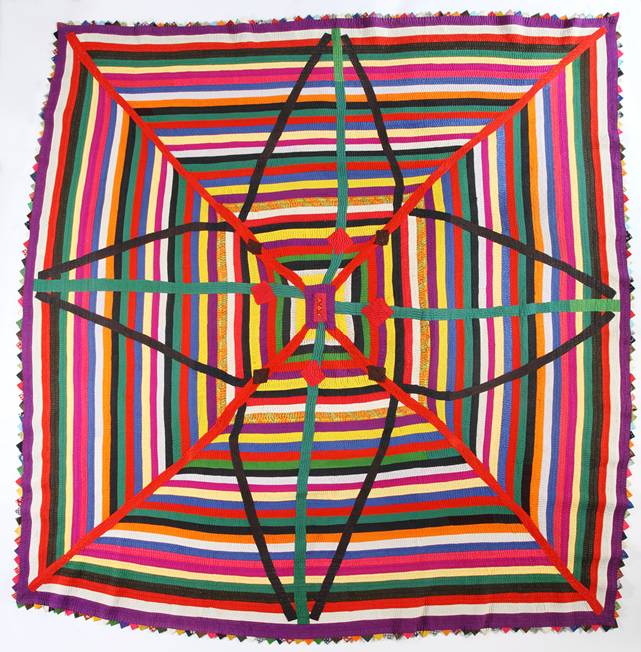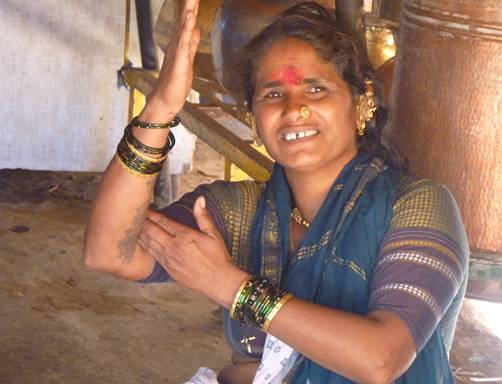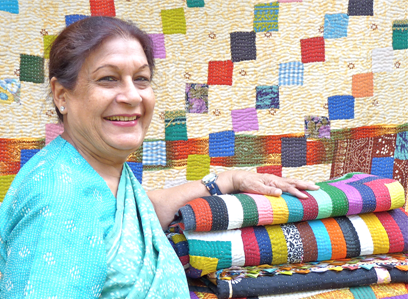
This has been an amazing journey in discovering myself through quilt making and fabric. I am convinced that each fabric gives out its own distinctive scent.
To understand better about quilts and quilt making in my state, I set out to researching quilt making in Maharashtra. The first stop being Lonavla. To my surprise, I found that the simplest quilts were made in Maharashtra, in comparison to the decorative Bengal Kantha or the embroidered Punjab Phulkari.
In Maharashtra, these quilts are called ‘godharis’. A very simple technique is used unlike the quilts of other areas in India. The godharis are essentially made from everyday worn pieces of cloth, patched together to reinforce the torn parts. They add layer upon layer of saris to give durability and warmth. Born out of necessity, the materials are stretched to their limits, reinforced with stitches. This is a freestyle of art, as they use whatever material is available and intuitively a unique design appears.
The in-between-layers are filled with used trousers and shirts ripped open and laid out flat. Using a heavy gauged cotton thread, a running stitch is hand-stitched through the multiple layers of cloth. Each godhari is therefore unique in its own way.
A woman’s innate contribution to be able to recycle food and clothing in everyday life needs an innate intelligence to create something as beautiful as a godhari. Each godhari tells an interesting story ---untold.
Smaller godharis, made from old worn saris, are traditionally used by a mother to cover and protect a newborn child. Thus the smell and feel of the mother’s old saris give the baby the comfort and an added sense of security and the mother’s presence is palpable for the child.
Embedded in tradition, the Maharashtrian women, chant a mantra or a folk song as they sew-along. The link between physically producing the quilt also has spiritual benefits for the maker and the user. The traditional skills are treasured in today’s world where intellectual and mental skills on electronics are valued more than artistic or physical skills.
These villages revealed to me godharis made of bold vibrant colours. It opened my eyes to their colour sense and style of quilt making.
Addition of political banners, which to me identified their relationship with the quilt, which added to their sense of creativity.
In Maharashtra, its mostly simple quilts are identified by their graphic forms.
Tools of use are their body parts, like the palm, fingers to elbow and one finger or two fingers apart while quilting. They use bricks or stones to hold the edges of the godhari to keep it in place.
As I went along in one of the villages a woman had used the swastik sign on her godhari, which is a very strong Indian motif where she relates to the blessings of the sun god. Even today we use this auspicious sign in our daily life as a living tradition.
We can identify the age of the quilt by the layers and the texture of the fabric.
In America, they have categorized old quilts as commemorative quilts, war and peace quilts, memory quilts, art quilts, but we in India have identified quilts by the states they are from related to the sarees, other fabrics, and accessories used.
We spent a lot of time traveling the dusty roads and by-lanes leading to distant villages and talking to the residents about how and why they were making godharies.
The common factor that I was able to relate to them was the nurturing of the family. Massive scope- with just one torn strip, able to create amazing designs. The unevenness of the godharis adds another quality to the piece.
When I tried to commission a piece by giving them my fabrics and explaining to them the colours I would have liked, they came up with atrocious samples. It would take me 10 trials before I could change their way of thinking, Their relationship to the fabric is important, and that too only for a brief time. They would always go back to their own traditional ways. In trying to change them or as we say educate them to market needs, we destroy their inner abilities to create. They completely absorb themselves in their work, without looking for any approval.
STORY
Filling the stomach of the godhari. Usually on completing the godhari, which is sewn from the outer edge towards the centre, stomach of the godhari, traditionally a pocket is made in the centre. This is filled with rice grains, turmeric, kumkum, and jaggery is placed within it. We were told that this was an offering to the Goddess Annapurna-which provides the family a full stomach through the year. The offering remains within the pocket under all conditions.

Mandala
Size 24x24” Square


On a black saree, worn only on “Sankranti Day” 14th. January Homage to the Sun God. This particular godhari depicts the sun god, the strips of cloth- the sunrays and planets around it, in their own creative way. The face represents the Sun, which is considered a powerful symbol in many cultures namely, Greek, Japanese, and Indian.
Size 96 x 104” approx.

Using body parts. Measuring from the tips of her fingers to her elbow which equals half a yard. No tools such a ruler or measure tape or chalk are used.

Geeta Khandelwal. Quilter, Quilt collector and textile artist
